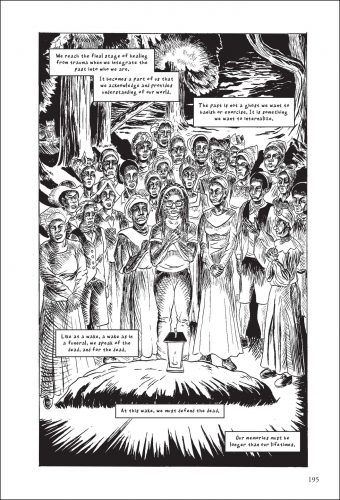
This month’s Kickass Women doubles as a review of the graphic novel Wake: The Hidden History of Women-Led Slave Revolts, by Rebecca Hall (Grade: A). This nonfiction book describes Hall’s efforts to uncover the history of women who led slave rebellions – women who often went unnamed and erased by history. Dr. Hall, who qualifies as a kickass woman in her own right, also describes the psychological toll of doing this research, and the way the erasure of these women affects us in daily life today.
Descriptions of enslavement, violence, execution, suicide, and trauma.
Sarah, Abigail, Lily, and Amba are listed as defendants in a New York trial report. They allegedly participated in, and possibly led, a revolt in New York City in 1712. A group of 27 enslaved people were arrested for the revolt, which included burning down a building, shooting the responders, and then fleeing.
We know from court records and letters that 21 of the defendants were executed, and that at least four of the defendants were women: Sarah, Abigail, Lily and Amba. One of them was a pregnant woman whose “election was stayed” because of the pregnancy. None of them have last names or other identifying details listed in court records or letters.

Sarah and Abigail were convicted, but Lily and Amba were not. As far as three years after the revolt, the governor asked for a reprieve for the woman who had been pregnant (we don’t know if this woman was Sarah or Abigail). She had spent all this time in a hell hole of a jail, one which was not intended to house prisoners for long amounts of time. Her ultimate fate is unknown.
On English slave ships, women were recorded only by number and sometimes gender and estimated age. Hall describes in detail the blocks she encounters in trying to identify these women, women whose lives continue to be deliberately obscured by sexist and racist practices in both public and private institutions.
Although Hall is not able to identify women who rebelled on slave ships by name, she is able to uncover evidence that women led revolts aboard. Revolts at sea were suicidal and yet they occurred on one out every ten voyages. Hall finds that, “The more women were onboard a slave ship, the more likely a revolt would occur.” It was common practice for women to be brought aboard decks once a ship was in the open sea, and for these women to be unchained – even near the stores of weapons.
A report of the Lords of The Privy Council, 1789, states:
The Slave, if a Man, is put in Irons on the Main Deck; if a Boy, he is put on the Main Deck loose; if a Woman or a Girl, they are placed without Irons on the Quarter Deck.
Weapons were usually stored on the Quarter Deck.
Hall speculates that the sexism of slavers was so ingrained that no matter how many revolts occurred, they simply could not grasp the concept that a woman might lead a revolt, and yet revolts occurred again and again, as on The Thomas in 1797:
Two or three of the female slaves having discovered that the armorer had incautiously left the arms chest open, conveyed all the arms which they could find through the bulkheads to the male slaves, about two hundred of whom immediately ran up the forescuttles, and put to death all the crew who came in their way.
Hall uses her historical knowledge and imagination to create possible narratives of who some of these women were, and what happened to them. These narratives challenge previous assumptions that women did not lead or participate in revolts. She also draws clear lines between what happened then and what is happening now, between past and present. In this she is aided by the remarkable art of Hugo Martínez.

To learn more about Sarah, Abigail, Lily, Amba, and others, read Wake by Dr. Rebecca Hall.
To hear a podcast with Dr. Rebecca Hall, check out the Unsung History podcast.


There are people I would like to give this book to.
Speaking of kick-ass women, Stacey Abrams guest-starred (as the president of United Earth!) on the season conclusion of Star Trek: Discovery. 🙂
Thanks for this review, Carrie. I will be checking out the podcast.